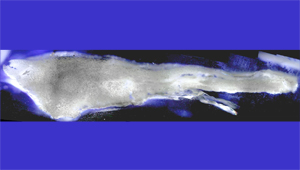

Auch die versteinerte Kierfernschuppe biegt sich bei Befeuchtung gegen die Schwerkraft aufwärts und bei Trocknung wieder zurück in ihre Ausgangsposition. Bild: BP, WZS)
“For the first time we applied a previously developed and refined 'bio-templating' process to create materials with a structure-based functionality- in cooperation with the Institute of Physics of the Austrian Montanuniversitaet Leoben and the Max-Planck-Institute for Colloids and Interfaces in Potsdam”, said Dr. Daniel Van Opdenbosch, who is working at the Science Center Straubing.
With this approach, one can artificially petrify pine cones, completely transforming the biological components into the technical material silica glass. Elaborate analyses at the particle accelerator BESSY II in Berlin showed that the internal structure of the pine cone was retained. Crucially, it was petrified completely and accurately – down to the smallest hierarchical level of only millionths of millimeters.
Van Opdenbosch: “We could induce the obtained samples to move in a similar manner as their biological originals during the uptake of moisture. The scales of the petrified cones move upward against gravity, and on drying back to their starting positions.
“ The scientists hope that the precise templating of plant structures, and the corresponding retention of their characteristic properties, will be a pathway for the development of functional materials. Based on the current results, they say that the preparation of porous ceramic multilayer-sensors is possible with comparatively low expenditure. Such novel sensors react to changes in moisture with angular movement.
They could therefore be used to measure, switch or control in chemically or physically aggressive environments. Conventional bimetal or other bilayer actuators are, due to their composition of metals or polymers, prone to corrosion through acid- or base attacks, as well as oxidative, thermal or physical degradation. Against all of these factors, ceramic oxides, such as silica glass, are particularly resistant.
The project “Hierarchically structured porous ceramics and composites from nanocasting of plant cell walls” was carried out in the frame of the Priority Programme 1420 “Biomimetic Materials Research: Functionality by Hierarchical Structuring of Materials” funded by the German Science Community (Deutsche Forschungsgemeinschaft). The scientists published their work in the esteemed journal “Advanced Materials” (May 6th 2016, DOI-number 10.1002/adma.201600117).
Contact:
Technical University of Munich
Science Center Straubing
Jan F. Turner
Schulgasse 16
94315 Straubing
Phone 09421 187 163
Mail: j.turner@wz-straubing.de
http://www.wz-straubing.de/default.asp?menue=230&ShowNews=ON&Artikel=186…












